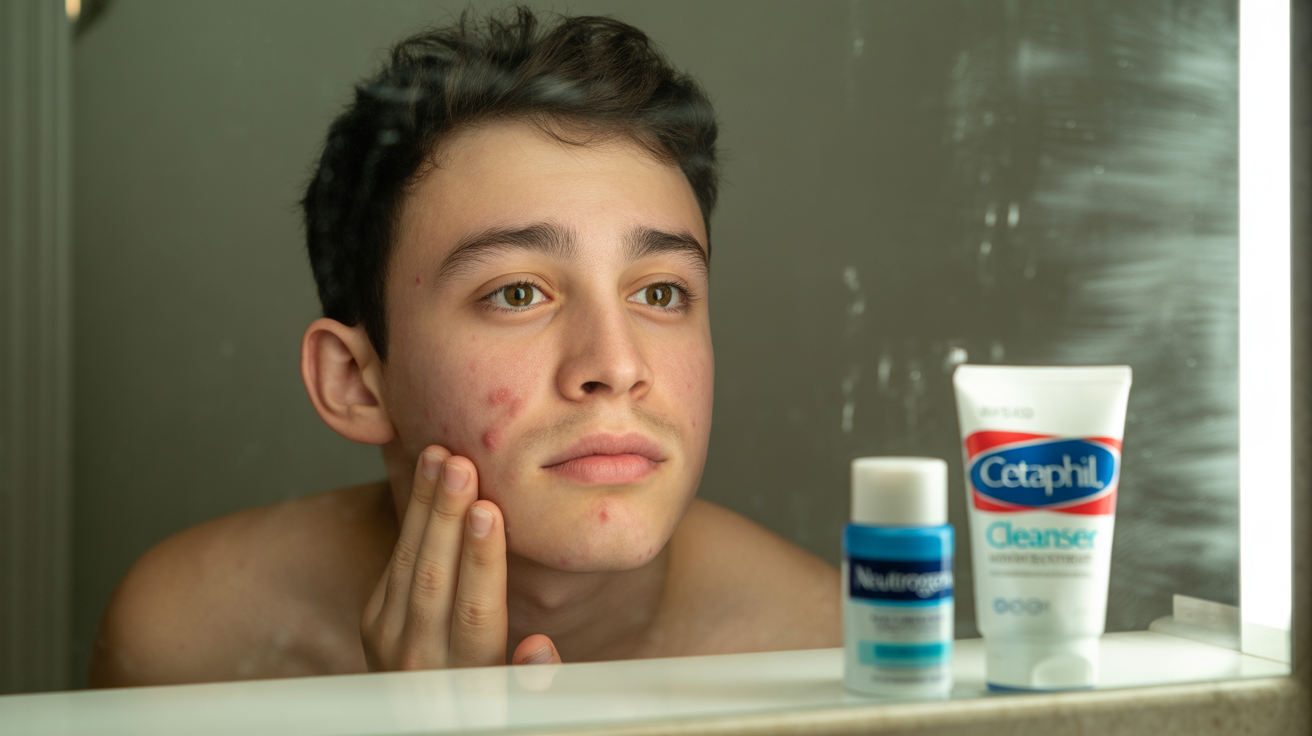Teen Boy Skincare: Simple Tips for Clear, Healthy Skin

When my son turned thirteen, I watched his confidence fade as his skin changed overnight. Suddenly, this happy kid was avoiding mirrors and making excuses to skip social events.
Sound familiar? If you’re a teen boy dealing with new skin challenges, you’re not alone. Puberty brings hormonal changes that can turn even the clearest skin upside down.
Building good skincare habits now isn’t just about looking good today. It’s about protecting your skin for years to come and maintaining your confidence.
This guide will walk you through simple routines that work for every skin type, as well as solutions for those frustrating breakouts and oily patches that seem to appear out of nowhere.
Understanding Teen Boy Skin
Your skin is going through significant changes right now, and that’s completely normal. During puberty, your body produces more hormones called androgens.
These hormones tell your oil glands to work overtime, which often leads to shinier skin and more breakouts.
Every person’s skin is different, though. Some teens struggle with constant oiliness, while others experience dry patches or sensitivity. Understanding your skin type is the first step to caring for it properly.
Here’s a simple way to figure out your skin type. Wash your face with a gentle cleanser and wait about an hour before applying anything to your skin. Then check how your skin feels and looks.
If your whole face feels tight and looks flaky, you likely have dry skin. If your T-zone (forehead, nose, and chin) is shiny but your cheeks feel normal, you have combination skin.
Oily skin will feel greasy all over and might look shiny. Sensitive skin often feels irritated or burns easily with new products.
Core Skincare Routine Steps (For All Skin Types)
These four basic steps form the foundation of any effective skincare routine, regardless of your skin type. Master these basics first; then you can add targeted treatments for specific concerns later.
Step 1: Cleansing

Wash your face twice daily to remove dirt, oil, and bacteria. Choose your cleanser based on your skin type.
For oily/acne-prone skin: Gel or foaming cleansers with salicylic acid (like Neutrogena Oil-Free Acne Wash).
For dry/sensitive skin: Cream cleansers or fragrance-free options (like Cetaphil Gentle Skin Cleanser)
Step 2: Exfoliation

Exfoliate 1-2 times per week to prevent clogged pores and remove dead skin cells. Chemical exfoliants like salicylic acid are often gentler than physical scrubs for teen skin.
Remember: More isn’t better; over-scrubbing can increase oil production and cause irritation.
Step 3: Moisturizing

Every skin type needs hydration. When skin is properly moisturized, it produces less excess oil.
For oily/acne-prone skin: Lightweight, oil-free moisturizers (like Neutrogena Hydro Boost).
For dry/sensitive skin: Richer formulas with ceramides (like CeraVe Moisturizing Cream)
Step 4: Sun Protection

Apply broad-spectrum SPF 30+ sunscreen every morning, even on cloudy days. UV damage adds up over time and can cause premature aging and skin cancer.
Best options: EltaMD UV Clear or Neutrogena Clear Face Sunscreen – both won’t clog pores or feel greasy.
Targeted Solutions for Common Teen Skin Issues

Even with a solid basic routine, you might need extra help for specific problems like stubborn breakouts or razor burn. Here are targeted solutions for the most common issues teen boys face.
Acne and Breakouts
When pimples appear, please resist the urge to pick at them. I know it’s tempting, but picking can lead to scarring and spread bacteria to other areas of your face.
Instead, use spot treatments with benzoyl peroxide or salicylic acid. These ingredients help kill acne bacteria and unclog pores. Apply a small amount directly to the pimple before bed and let it work overnight.
Keep all your products non-comedogenic, which means they won’t clog your pores.
Oiliness and Shine
If your skin gets shiny throughout the day, carry blotting papers in your backpack. These thin sheets absorb excess oil without disturbing your skincare routine. Just press gently on oily areas and throw the paper away.
Avoid the temptation to wash your face multiple times a day or use harsh, alcohol-based products. These actually signal your skin to produce even more oil to compensate.
Dryness and Sensitivity
Look for products with soothing ingredients like aloe vera, ceramides, and hyaluronic acid. These help calm irritation and add moisture back to your skin.
Be extra gentle with sensitive skin. Pat your face dry instead of rubbing, and always patch test new products on a small area first.
Ingrown Hairs and Shaving Irritation
If you’re starting to shave, always use a sharp, clean razor and shaving cream or gel. Shave in the direction your hair grows, not against it. This reduces irritation and prevents ingrown hairs.
After shaving, use an alcohol-free aftershave balm to soothe your skin. Many traditional aftershaves contain alcohol that can dry out and irritate young skin.
Building a Routine for Your Skin Type
Now that you know your skin type, it’s time to create a personalized routine that works for you. These step-by-step guides will help you create morning and evening routines tailored to your specific needs.
For Oily/Acne-Prone Skin
Focus on controlling excess oil production while keeping skin properly hydrated and preventing breakouts from forming.
- Morning: Gentle foaming cleanser, lightweight moisturizer, sunscreen
- Evening: Same cleanser, exfoliate 1-2 times per week, moisturizer, spot treatment if needed
Product Recommendations
| Product Type | Recommended Products |
|---|---|
| Cleansers | |
| Exfoliators | |
| Moisturizers | |
| Sunscreens |
For Dry/Sensitive Skin
Prioritize gentle, deeply hydrating products that soothe irritation and strengthen your skin’s protective barrier.
- Morning: Cream cleanser, rich moisturizer, sunscreen
- Evening: Same cleanser, exfoliate once per week (gentle formula), heavier night moisturizer
Product Recommendations
| Product Type | Recommended Products |
|---|---|
| Cleansers | |
| Exfoliators | |
| Moisturizers | |
| Sunscreens |
For Combination Skin
Balance is key here; treat different areas of your face with products specifically suited to their individual needs.
- Morning: Use gel cleanser on T-zone, lightweight moisturizer on oily areas, gentler products on cheeks, sunscreen all over
- Evening: Same targeted approach, adjust exfoliation by area needs (more for T-zone, less for dry areas)
Product Recommendations
| Product Type | Recommended Products |
|---|---|
| Cleansers | |
| Exfoliators | |
| Moisturizers | |
| Sunscreens |
Skincare Do’s and Don’ts for Teen Boys

Following these simple rules can make the difference between clear, healthy skin and ongoing problems. These are the mistakes I see most teens make, along with the habits that work.
DO:
- Be consistent with your routine. Stick to it for at least 4-6 weeks to see real results
- Use gentle, fragrance-free products designed for your skin type
- Patch test new products on a small area before using them on your whole face
- Apply sunscreen every single day, even when it’s cloudy
- Keep your hands clean before touching your face
- Change your pillowcase regularly to avoid bacterial buildup
DON’T:
- Over-washing your face, more than twice daily, can strip natural oils and cause irritation
- Pick, squeeze, or pop pimples. This can lead to scarring and the spread of bacteria
- Use harsh scrubs or exfoliate daily. This can damage your skin barrier
- Skip moisturizer because you think it will make you more oily
- Share face towels or use dirty washcloths on clean skin
- Give up on a product after just a few days. Real changes take time
Remember, skincare is a marathon, not a sprint. Results take time, and that’s completely normal.
Conclusion
Finding the right skincare routine is like finding the perfect pair of jeans. It takes some trial and error, but when you find what works, it makes all the difference.
Remember that healthy skin comes from consistency, not perfection. You don’t need a bathroom full of expensive products to have good skin.
Start with the basics: gentle cleanser, moisturizer, and sunscreen. Add other products slowly as you learn what your skin needs. Most importantly, be patient with yourself and your skin.
Those teenage years are tough enough without the added stress of skin troubles, but with the right care and patience, you’ll get through this phase with confidence and healthy habits that will serve you well for life.
Frequently Asked Questions
How Long Until I See Results?
Most people see some improvement in 4-6 weeks, but significant changes can take 2-3 months. Be patient with your skin.
Can I Use My Sister’s Or Mom’s Products?
While it’s tempting to borrow, adult skincare products are often too strong for teen skin. Stick with products designed for your age group.
What If My Skin Gets Worse Before It Gets Better?
This can happen when you start using active ingredients like salicylic acid. If it continues for more than a few weeks, consider seeing a dermatologist.






